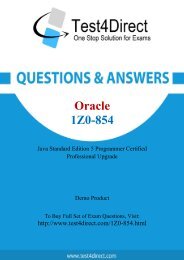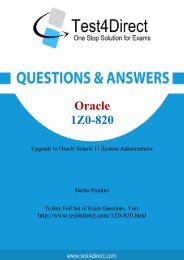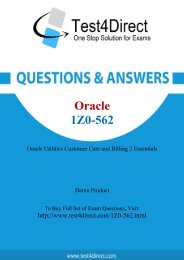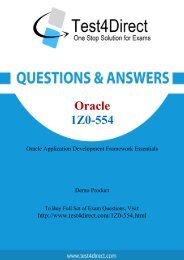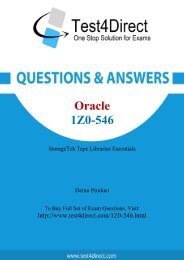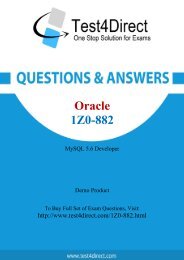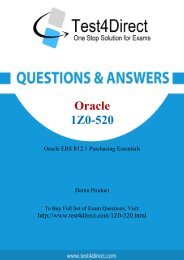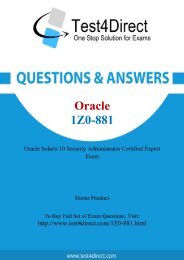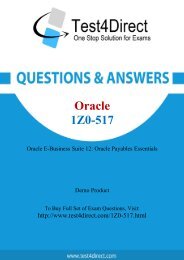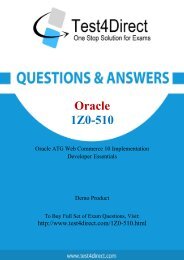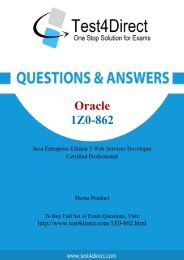1Z0-141 BrainDumps Discount
Test4Direct provides latest PDF questions of Oracle 1Z0-141 exam. You have an opportunity to pass the Oracle 1Z0-141 exam in one go. Test4Direct is most accurate source to prepare Oracle 1Z0-141 exam as your success will become site’s responsibility after purchasing 1Z0-141 exam product. There are also lots of discounts and promotion offers that you can avail. Let’s try a free demo http://www.test4direct.com/1Z0-141.html
Test4Direct provides latest PDF questions of Oracle 1Z0-141 exam. You have an opportunity to pass the Oracle 1Z0-141 exam in one go. Test4Direct is most accurate source to prepare Oracle 1Z0-141 exam as your success will become site’s responsibility after purchasing 1Z0-141 exam product. There are also lots of discounts and promotion offers that you can avail. Let’s try a free demo http://www.test4direct.com/1Z0-141.html
You also want an ePaper? Increase the reach of your titles
YUMPU automatically turns print PDFs into web optimized ePapers that Google loves.
Oracle<br />
<strong>1Z0</strong>-<strong>141</strong><br />
Oracle Forms: Build Internet Applications<br />
Demo Product<br />
To Buy Full Set of Exam Questions, Visit:<br />
http://www.test4direct.com/<strong>1Z0</strong>-<strong>141</strong>.html
Question: 1<br />
The DBA has added STATE column to the CUSTOMERS table and has asked you to add a<br />
corresponding State item to the Customers block of the Orders form. You want to make it easier for<br />
order entry clerks to enter the correct state abbreviation. Most customers are located in five<br />
southeastern states, although on very rare occasions there will be customers from outside that area.<br />
You decide to implement a list item with five values for the State item and allow clerks to enter the<br />
state abbreviation director for those customers outside `the region. Which style of list item will you<br />
create for the State item?<br />
A. A poplist<br />
B. A Tlist<br />
C. A combo box.<br />
D. There is no style of list item that allows users to enter values that are not on the list.<br />
Answer: C<br />
Explanation:<br />
Combo box: Appears as a field with a downarrow next to its right side (Use the button to display all<br />
the combo box list elements. The combo box accepts user input.)<br />
Reference:<br />
Oracle 9i: Forms Developer Build Internet Application M8-P11<br />
Question: 2<br />
Exhibit:
You want to create a new data block. You click the Data Blocks node in the Object Navigator, and then<br />
you click Create to invoke the Create Data Block dialog box. As you click through the pages of the<br />
wizard, the page shown in the exhibit appears. After looking at the exhibit, what do you know is true<br />
about this form?<br />
A. The block you are creating is based on a view.<br />
B. The block you are creating is based on a stored procedure.<br />
C. The form contains at least one block in addition to the block you are creating.<br />
D. In addition to the block you are creating, the form contains at least two other blocks that are<br />
master detail blocks.<br />
E. The block you are creating is based on a table that has at least one foreign key relationship to<br />
another table.<br />
Answer: C<br />
Explanation:<br />
You can build a master-detail form module either by creating a relation between a master and detail<br />
block explicitly ,or implicitly by using the Data Block Wizard.<br />
Create the master block as described earlier in this lesson in the topic Creating a New Data Block.<br />
Invoke the Data Block Wizard in the Object Navigator.<br />
Follow the same steps as before to create a new data block in the Data Block Wizard until you come<br />
to the Master-Detail page.<br />
Reference:<br />
Oracle 9i: Forms Developer Build Internet Application M4-P32<br />
Question: 3<br />
You are creating an application on a Windows PC, and you want to test a form. What are two ways to<br />
start an OC4J instance on the PC? (Choose two)<br />
A. From the Forms Builder menu.
B. From the Windows Start menu.<br />
C. By executing a batch file that is included with Oracle9iDS.<br />
D. From the test form that is included with Oracle9iDS.<br />
E. From the HTML front end (runform.htm) that is included with Oracle9iDS.<br />
F. By running a Forms Builder form, which automatically starts OC4J.<br />
Answer: B, C<br />
Explanation:<br />
To use OC4J on Windows NT, you start it by executing the batch file provided, called startinst.bat. This<br />
file is located in the j2ee\Oracle9iDS\ subdirectory of ORACLE_HOME. If you will be testing your<br />
applications on your client machine, it is a good idea to set up a shortcut to this batch file, and also to<br />
the batch file to stop the OC4J instance, called stopinst.bat.<br />
Reference:<br />
Oracle 9i: Forms Developer Build Internet Application M3-P17<br />
Question: 4<br />
While updating an existing customer record using the Customers form, the user invoked the Orders<br />
form by clicking the CONTROL.Orders_btn button. The When-Button-Pressed trigger had the<br />
following code:<br />
CALL_FORM(‘orders’);<br />
There is a requirement to navigate back to the Customers form after the order details have also been<br />
updated. This will be achieved through a form-level Key-Exit trigger in the Orders form. Which code<br />
should be used?<br />
A. IF GET_APPLICATION_PROPERTY(calling_form) IS NOT NULL THEN EXIT_FORM(ASK_COMMIT,<br />
NO_ROLLBACK; ELSE<br />
EXIT_FORM;<br />
END IF;<br />
B. VALIDATE(FORM_SCOPE); IF :SYSTEM.FORM_STATUS ‘QUERY’ THEN GO_FORM(‘customers’);<br />
ELSE
EXIT_FORM;<br />
END IF;<br />
C. ENTER; IF :SYSTEM.CURSOR_BLOCK = ‘CHANGED’ THEN COMMIT_FORM; ELSE<br />
EXIT_FORM(NO_VALIDATE, NO_ROLLBACK);<br />
END IF;<br />
D. IF :SYSTEM.FORM_STATUS = ‘CHANGED’ THEN COMMIT_FORM:<br />
END IF;<br />
GO_FORM(customers’);<br />
Answer: A<br />
Explanation:<br />
Reference:<br />
Oracle Forms Developer 6i: Build Internet Applications II M9-P17<br />
Question: 5<br />
Your company assigns three possible credit ratings to customers: Poor, Good, and Excellent<br />
(represented numerically by 1, 2, and 3). The DBA has just added a RATING column to the<br />
CUSTOMERS table and has asked you to add an item to your form so that data entry clerks can<br />
populate the RATING column. To restrict data entry clerks to one of these three values, you decide to<br />
create a radio group for the Rating item. With the Customers block selected in the Layout Editor, you<br />
use the radio button to create three radio buttons on the canvas. You then set the labels (Poor, Good,<br />
and Excellent) and values (1, 2, and 3) for the radio buttons. You set the name of the radio group to<br />
RATING, its Data Type to Number, and its Database column to Rating .You run the form to test it.<br />
When you execute a query, however, no records are returned, although there are many customer<br />
records in the database.<br />
What can you do to make the query return the records?<br />
A. Set the Mapping of Other Values property for the radio group to Null.<br />
B. Create a fourth radio button for an undetermined credit rating and leave its value blank.<br />
C. Create a fourth radio button for an undetermined credit rating and explicitly set its value to Null.
D. Choose a different type of input, because radio groups do not allow query of Null values.<br />
Answer: A<br />
Explanation:<br />
Handling Other Values in a Radio Group If the base table column for a radio group accepts values<br />
other than those associated with your radio buttons, you must use one of the following methods to<br />
specify how you want to handle the values:<br />
Ignore other values (by leaving the radio group’s Mapping of Other Values property blank)<br />
Associate the other values with one of the existing radio buttons (by naming the associated value of<br />
the button in the Mapping of Other Values property) Note: Ignoring other values results in the entire<br />
row being ignored during query processing. NULL Values in a Radio Group A radio group can treat<br />
NULL as a valid value. You should account for the NULL case, if your base table column allows them.<br />
Do this in one of the following ways:<br />
Use the Mapping of Other Values property to implicitly force NULL to a radio button.<br />
Assign the NULL to its own radio button.Note: To assign a NULL value, leave the Radio Button Value<br />
property blank.<br />
Reference:<br />
Oracle 9i: Forms Developer Build Internet Application M8-P23<br />
Question: 6<br />
You are editing the INVENTORY tab canvas. You set the Tab Attachment Edge property to RIGHT .You<br />
also change the ordering of INVENTORY tab pages in the Object Navigator. The Direction property has<br />
not been customized.<br />
What influence will this have on the display of tab pages at run time?<br />
A. The highest tab page in the Object Navigator will appear at the far left of the tab stack.<br />
B. The highest tab page in the Object Navigator will appear at the top of the tab stack.<br />
C. The highest tab page in the Object Navigator will appear at the far right of the tab stack.<br />
D. The highest tab page in the Object Navigator will appear at the bottom of the tab stack.<br />
E. The lowest tab page in the Object Navigator will appear at the start of the tab stack.
Answer: B<br />
Question: 7<br />
In the Product.fmb module, data block items are displayed on two content canvases. You define a set<br />
of icon buttons that users must have access to at all times.<br />
Which canvases type is appropriate to display the buttons?<br />
A. Overlay stacked canvas.<br />
B. Overlay Tab canvas that is associated with a separate window.<br />
C. Content canvas that is associated with the same window as the two content canvases.<br />
D. Horizontal Toolbar canvas that is associated with a separate window.<br />
E. Horizontal Toolbar canvas that is associated with the same window as the two content canvases.<br />
Answer: E<br />
Question: 8<br />
Exhibit: You are developing an Order Entry form. The When-New-Form-Instance trigger executes a<br />
query on the only block in the form. Instead of the alert shown in the exhibit, when the query cannot<br />
be performed you want to display to the user a message with the actual database error that is<br />
received.<br />
What can you do to implement this?
A. In the When-New-Form-Instance trigger, insert this code after the EXECUTE_QUERY built in: IF<br />
NOT FORM _SUCCESS THEN<br />
message(DBMS_ERROR_TEXT);<br />
END IF;<br />
B. In the When-New-Form-Instance trigger, insert this code after the EXECUTE_QUERY built in: IF<br />
NOT FORM_SUCCESS THEN<br />
message(SQLERRM);<br />
END IF;<br />
C. Place this code in a form-level On-Error trigger: IF ERROR_CODE = 40505 THEN<br />
message(DBMS_ERROR_TEXT);<br />
END IF;<br />
D. Place this code in a form-level On-Error trigger: IF ERROR_CODE = 40505 THEN<br />
message(SQLERRM);<br />
END IF;<br />
E. Add this exception handler to the When-New-Form-Instance trigger:<br />
EXCEPTION<br />
WHEN ERROR_CODE = 40505 THEN<br />
MESSAGE(DBMS_ERROR_TEXT);<br />
F. Add this exception handler to the When-New-Form-Instance trigger:<br />
EXCEPTION<br />
WHEN ERROR_CODE = 40505 THEN<br />
MESSAGE(SQLERRM);<br />
Answer: C<br />
Question: 9<br />
Exhibit: Which of the items depicted in the Menu Editor (shown in the exhibit) must contain PL/SQL
code?<br />
A. Exit and Save only.<br />
B. File, Edit, and Customers only.<br />
C. All items shown in the Menu Editor should contain PL/SQL code.<br />
D. Exit, Save, Customers Report, Open Customers, and Call Customers only.<br />
E. Exit, Save, Cut, Copy, Paste, Customers Form, Customers Report, Open Customers, and Call<br />
Customers only.<br />
Answer: D<br />
Question: 10<br />
To centralize some of your processing, you decide to write PL/SQL library modules that contain<br />
procedures that can be called from the triggers or menu items .You want the message “Credit limit<br />
exceeded” to be displayed when the values in the order_total and credit_limit fields in the Orders<br />
form meet certain criteri<br />
a.<br />
Which code do you use?<br />
A. IF :order_total > 10000 AND :credit_limit < 10000 THEN MESSAGE(‘Credit limit exceeded’);<br />
END IF;<br />
B. IF :SYSTEM.cursor_item > 10000 AND :SYSTEM.trigger_item < 10000 THEN MESSAGE(‘Credit limit<br />
exceeded’);<br />
END IF;<br />
C. IF NAME_IN(‘order_total’) > 10000 AND NAME_IN(‘credit_limit’) < 10000 THEN MESSAGE(‘Credit
limit exceeded’);<br />
END IF;<br />
D. IF COPY(‘ORDERS.order_total’) > 10000 AND COPY(‘ORDERS.credit_limit’) < 10000 THEN<br />
MESSAGE(‘Credit limit exceeded’);<br />
END IF;<br />
E. IF :ORDERS.order_total > 10000 AND :ORDERS.credit_limit < 10000 THEN MESSAGE(‘Credit limit<br />
exceeded’);<br />
END IF;<br />
Answer: C<br />
Question: 11<br />
How can you programmatically determine which button a user pressed to respond to an alert?<br />
A. Use the GET_ALERT_PROPERTY function.<br />
B. Use the GET_ALERT_BUTTON_PROPERTY function.<br />
C. Check the value returned by the SHOW_ALERT function to see if it is 1, 2, or 3.<br />
D. Check the value returned by the SHOW_ALERT function to see if it is ALERT_BUTTON1,<br />
ALERT_BUTTON2, or ALERT_BUTTON3.<br />
E. Check the value returned by the SHOW_ALERT function to see if it is ALERT_BUTTON1,<br />
ALERT_BUTTON2, or ALERT_BUTTON3.<br />
Answer: D<br />
Explanation:<br />
OR E - BECAUSE THEY ARE THE SAME<br />
Question: 12
You should enable the user to add additional values to a list item at run time. You must also ensure<br />
that the Record Group LOCATIONS, which is used to populate the list item, can be updated with any<br />
user-supplied value.<br />
What two actions could you take to accomplish this? (Choose two)<br />
A. Add a new value to the list item by calling the POPULATE_LIST built-in.<br />
B. Add a new value to LOCATIONS by calling the POPULATE_GROUP built-in.<br />
C. Add a new value to the list item by calling the ADD_LIST_ELEMENT built-in.<br />
D. Remove duplicate values in LOCATIONS by calling the DELETE_LIST_ELEMENT built-in.<br />
E. Add a new value to LOCATIONS by calling the ADD_GROUP_ROW and SET_GROUP_CHAR_CELL<br />
built-ins.<br />
F. Add a new value to LOCATIONS by calling the ADD_GROUP_ROW and<br />
SET_GROUP_NUMBER_CELL built-ins.<br />
Answer: C,E<br />
Question: 13<br />
You write a form in which there are two text items (FIELD 1 and FIELD2) and a button (BTN1)<br />
arranged in the following sequence:<br />
FIELD1, BTN2, FIELD2<br />
Which three conditions will combine to produce a Navigation Trap when the focus is in FIELD1 and<br />
the user presses the [Next Item] key? (Choose three)<br />
A. FIELD1 has a Post-Text-Item trigger that fails.<br />
B. FIELD1 has a Pre-Text-Item trigger that fails.<br />
C. FIELD1 has a When-New-Item-Instance trigger that fails.<br />
D. FIELD2 has a Post-Text-Item trigger that fails.<br />
E. FIELD2 has a Pre-Text-Item trigger that fails.<br />
F. FIELD2 has a When-New-Item-Instance trigger that fails.<br />
G. The Keyboard Navigable property of BTN1 is set to No.
H. The Keyboard Navigable property of BTN1 is set to Yes.<br />
Answer: B,E,G<br />
Question: 14<br />
Which two statements define a Static Record Group? (Choose two)<br />
A. The Record Group can be created only at run time.<br />
B. The Record Group is not associated with a query.<br />
C. The Record Group can be created and modified only at design time.<br />
D. The Record Group can be created and modified at design time or at run time.<br />
E. You can modify the structure of this Record Group by adding columns and rows at run time.<br />
F. You can modify the structure of this Record Group by associating it with a query at run time.<br />
Answer: B,C<br />
Question: 15<br />
There is a requirement in the Orders form to direct the focus depending on the value in the Sales Rep<br />
Id text item. The design team has not yet decided on the exact details, but you propose the following<br />
style of code:<br />
IF :ORDERS.Sales_Rep_Id = … THEN --value to be decided later GO_ITEM(…); --item to be decided<br />
later ELSE GO_ITEM(…); --item to be decided later END IF;<br />
A colleague suggest that the code could be called from the triggers listed below. In fact, not all these<br />
triggers can execute the code.<br />
Which three triggers can call the code? (Choose three)<br />
A. Post-Block on the Orders block.<br />
B. Pre-Block on the Order_Items block.
C. When-New-Block-Instance on the Orders block.<br />
D. Post-Text-Item on the Sales Rep Id text item.<br />
E. When-Validate-Item on the Sales Rep Id text item.<br />
F. When-New-Block-Instance on the Order_Items block.<br />
Answer: C,E,F<br />
Question: 16<br />
The REGIONS non-query Record Group has two char columns. Which built-in can you use to replace<br />
any existing rows in REGIONS with the results of a query?<br />
A. ADD_GROUP_ROW(‘REGIONS’,2);<br />
B. rgno :- POPULATE_GROUP(‘REGIONS’);<br />
C. rgno := POPULATE_GROUP_WITH_QUERY(‘REGIONS’, ‘select name, country, id from<br />
regiontable’);<br />
D. rgno := CREATE_GROUP_FROM_QUERY(‘REGIONS’, ‘select name, country, id from regiontable’)<br />
E. rgno := CREATE_GROUP_FROM_QUERY(‘REGIONS’, ‘select name, country from regiontable’);<br />
F. rgno := POPULATE_GROUP_WITH_QUERY(‘REGIONS’, ‘select name, country from regiontable’);<br />
G. You cannot populate a non-query Record Group with the results of a query.<br />
Answer: F<br />
Question: 17<br />
You are a developer in the IT department of a municipal utility. You have been tasked with integrating<br />
two applications that are already in production.<br />
The first application is a customer management system. Its main form is the Customers form, in<br />
which utility clerks enter and update customer information.<br />
The second application is a GIS application. One of its forms, the Address form, enables clerks to<br />
enter an address, click a button, and have the address verified and property formatted according to
postal standards.<br />
You need to add a button to the Customers form that will pass the customer address to the Address<br />
form and receive the properly formatted address back. A variable of the user-defined type Addr_Typ<br />
will contain the address information to be passed back and forth between the two users.<br />
Which method of sharing data will you use?<br />
A. Global variables<br />
B. Global record group<br />
C. Parameters<br />
D. Shared PL/SQL library<br />
E. There is no method of sharing data that enables you to use a variable of a user-defined type.<br />
Answer: D
THANKS FOR TRYING THE DEMO OF OUR PRODUCT<br />
Visit Our Site to Purchase the Full Set of Actual <strong>1Z0</strong>-<strong>141</strong> Exam Questions With Answers.<br />
http://www.test4direct.com/<strong>1Z0</strong>-<strong>141</strong>.html<br />
We Also Provide Practice Exam Software That Simulates Real Exam Environment And Has<br />
Many Self-Assessment Features. Download Free Product Demo From:<br />
http://www.test4direct.com/<strong>1Z0</strong>-<strong>141</strong>.html<br />
Money Back Guarantee<br />
Check Out Our Customer Testimonials






